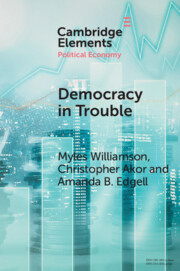14293 results in Political economy

Constructing Modern Slavery
- Law, Capitalism, and Unfree Labour
-
- Published online:
- 09 January 2025
- Print publication:
- 23 January 2025
-
- Book
-
- You have access
- Open access
- Export citation

Economics without Preferences
- Microeconomics and Policymaking Beyond the Maximizing Individual
-
- Published online:
- 02 January 2025
- Print publication:
- 16 January 2025

Polluted Politics
- The Development of an Israeli-Palestinian E-Waste Economy
-
- Published online:
- 18 December 2024
- Print publication:
- 05 December 2024

Public Contracting for Social Outcomes
-
- Published online:
- 12 December 2024
- Print publication:
- 12 December 2024
-
- Element
-
- You have access
- Open access
- HTML
- Export citation

Democracy in Trouble
- Democratic Resilience and Breakdown from 1900 to 2022
-
- Published online:
- 12 December 2024
- Print publication:
- 16 January 2025
-
- Element
- Export citation
Dedication
-
- Book:
- Relocating Development Economics
- Published online:
- 05 December 2024
- Print publication:
- 12 December 2024, pp v-vi
-
- Chapter
- Export citation
Copyright page
-
- Book:
- Relocating Development Economics
- Published online:
- 05 December 2024
- Print publication:
- 12 December 2024, pp iv-iv
-
- Chapter
- Export citation
Index
-
- Book:
- Relocating Development Economics
- Published online:
- 05 December 2024
- Print publication:
- 12 December 2024, pp 181-185
-
- Chapter
- Export citation
4 - Regress
-
- Book:
- Relocating Development Economics
- Published online:
- 05 December 2024
- Print publication:
- 12 December 2024, pp 77-101
-
- Chapter
- Export citation
1 - The Context
-
- Book:
- Relocating Development Economics
- Published online:
- 05 December 2024
- Print publication:
- 12 December 2024, pp 19-33
-
- Chapter
- Export citation
Epilogue: Multiple Definitions of Progress and Development
-
- Book:
- Relocating Development Economics
- Published online:
- 05 December 2024
- Print publication:
- 12 December 2024, pp 151-160
-
- Chapter
- Export citation
References
-
- Book:
- Relocating Development Economics
- Published online:
- 05 December 2024
- Print publication:
- 12 December 2024, pp 161-177
-
- Chapter
- Export citation
6 - A Global Win–Win Model for Development
-
- Book:
- Relocating Development Economics
- Published online:
- 05 December 2024
- Print publication:
- 12 December 2024, pp 130-150
-
- Chapter
- Export citation
2 - The Beginnings of Indian Economics
-
- Book:
- Relocating Development Economics
- Published online:
- 05 December 2024
- Print publication:
- 12 December 2024, pp 34-58
-
- Chapter
- Export citation
1 - Introduction: Relocating Development Economics
-
- Book:
- Relocating Development Economics
- Published online:
- 05 December 2024
- Print publication:
- 12 December 2024, pp 1-18
-
- Chapter
-
- You have access
- HTML
- Export citation
Annex I - Archival Sources – Major Works of the First Generation of Modern Indian Economists, 1870–1905
-
- Book:
- Relocating Development Economics
- Published online:
- 05 December 2024
- Print publication:
- 12 December 2024, pp 178-180
-
- Chapter
- Export citation
Tables
-
- Book:
- Relocating Development Economics
- Published online:
- 05 December 2024
- Print publication:
- 12 December 2024, pp x-x
-
- Chapter
- Export citation
Contents
-
- Book:
- Relocating Development Economics
- Published online:
- 05 December 2024
- Print publication:
- 12 December 2024, pp vii-viii
-
- Chapter
- Export citation
5 - Developing Balanced Growth at Home
-
- Book:
- Relocating Development Economics
- Published online:
- 05 December 2024
- Print publication:
- 12 December 2024, pp 102-129
-
- Chapter
- Export citation
Acknowledgements
-
- Book:
- Relocating Development Economics
- Published online:
- 05 December 2024
- Print publication:
- 12 December 2024, pp xi-xii
-
- Chapter
- Export citation

